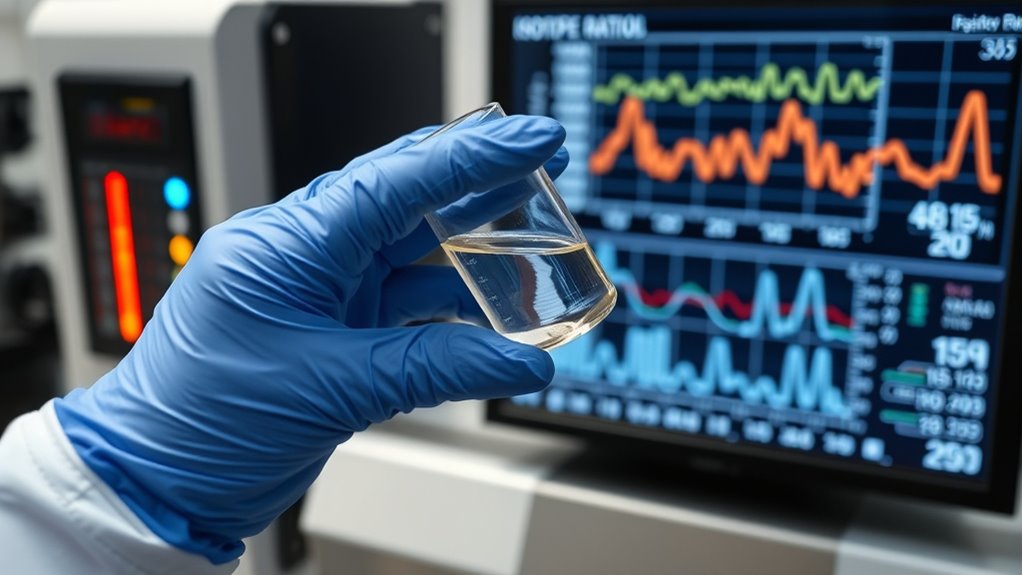If you want to identify food fraud, isotope ratio analysis is a key tool. It compares the ratios of stable isotopes like carbon-13 and oxygen-18 in food products, which vary based on geography and environment. These isotopic signatures act as unique fingerprints, helping you verify origin, detect adulteration, and confirm authenticity. This method is widely used in food safety and quality control. Keep exploring to see how this scientific approach can safeguard consumers and ensure product integrity.
Key Takeaways
- Isotope ratio analysis creates unique environmental fingerprints to verify the geographic origin of food products.
- It detects discrepancies in isotopic signatures that indicate product adulteration or fraud.
- Analyzing stable isotopes like carbon-13 and oxygen-18 helps differentiate genuine from counterfeit foods.
- Isotopic signatures reflect environmental and climatic conditions, supporting authenticity verification.
- This method enhances food safety, combats fraud, and ensures accurate labeling in the food industry.

Have you ever wondered how scientists determine the origins and processes behind various materials? One powerful tool they use is isotope ratio analysis, which plays an essential role in fingerprinting food fraud. This technique relies on analyzing specific environmental markers—unique isotopic signatures that materials naturally carry based on their geographical and environmental conditions. These markers help scientists trace the origin of food products with remarkable accuracy.
Isotope ratio analysis uncovers food origins through unique environmental isotopic signatures.
For example, the isotopic composition of water, plants, or animals reflects local climate, soil, and atmospheric conditions, creating a distinctive fingerprint that can be matched to a particular region or production method. Additionally, understanding isotopic variations is crucial for interpreting environmental influences that affect isotopic signatures. Recognizing how environmental factors impact isotopic ratios allows for more precise origin verification.
When it comes to authenticity verification, isotope ratio analysis shines. It enables experts to distinguish genuine products from counterfeit or adulterated ones, safeguarding consumers and producers alike. Imagine a scenario where high-quality olive oil from a renowned region is falsely labeled as coming from that area. Through isotope analysis, discrepancies in isotopic ratios related to water sources or plant metabolism reveal the fraud.
This scientific approach provides concrete evidence that supports or challenges claims about a product’s origin, making it an invaluable tool against food fraud.
The process involves measuring ratios of stable isotopes, such as carbon-13 to carbon-12 or oxygen-18 to oxygen-16. Because these ratios vary naturally depending on environmental factors, they serve as reliable markers.
For instance, sugar derived from cane or beet plants exhibits characteristic isotopic signatures, helping differentiate between natural and artificially sweetened products. Similarly, the isotopic profile of meat or dairy can indicate whether animals grazed in specific environments or were fed certain diets, confirming authenticity.
Moreover, isotope ratio analysis isn’t just about identifying geographic origin. It also provides insights into production methods, processing techniques, and even seasonal variations. This all-encompassing fingerprinting capability enhances the robustness of authenticity verification.
Food regulators and industry stakeholders increasingly rely on this scientific method to enforce labeling laws and combat fraud. In essence, isotope ratio analysis acts as a molecular detective, uncovering the true story behind every product by examining its environmental markers.
It empowers consumers to make informed choices, supports honest producers, and fortifies the integrity of the global food supply chain. With its precision and versatility, this technique continues to evolve, offering new ways to guarantee that what you eat is genuine and accurately represented.
Frequently Asked Questions
How Cost-Effective Is Isotope Ratio Analysis for Small-Scale Food Producers?
You wonder about isotope ratio analysis‘s cost-effectiveness for small-scale food producers. While it offers accurate fingerprinting for food fraud detection, the initial cost of equipment and testing can be high.
Conducting a thorough cost analysis helps determine scale feasibility, as smaller batches may not justify the expense. However, investing in this technology can boost your product’s credibility and differentiate your brand in a competitive market.
Can Isotope Ratio Analysis Detect All Types of Food Fraud?
You might think isotope ratio analysis can detect every type of food fraud, but it’s not that simple. While it’s excellent for adulteration detection and determining geographic origin, it can’t identify all frauds like mislabeling or contamination.
To get a full picture of food authenticity, you’ll need to combine isotope analysis with other methods, ensuring thorough fraud detection and safeguarding your products’ integrity.
How Quickly Can Isotope Ratio Analysis Results Be Obtained?
You can typically get isotope ratio analysis results within a few days, depending on the lab’s sample turnaround and testing efficiency. Faster processing might be possible with streamlined procedures, but standard timelines usually range from 48 to 72 hours.
This quick turnaround helps you identify food fraud swiftly, ensuring timely measures. Keep in mind, complex samples may require additional time, but overall, isotope analysis offers a relatively rapid detection method.
Are There Limitations to Isotope Ratio Analysis in Processed Foods?
You should know that isotope ratio analysis in processed foods has limitations. Sample contamination can skew results, making it harder to accurately identify authenticity.
Regional variability also affects isotope ratios, which may lead to misinterpretation if the food’s origin isn’t well understood.
These factors mean you need to carefully select and prepare samples, and consider regional differences, to guarantee the analysis provides reliable insights into food authenticity.
What Are Alternative Methods to Isotope Ratio Analysis for Food Authentication?
Imagine a detective gathering clues to uncover secrets in food. You can turn to spectroscopic techniques, which act like a fingerprint scanner revealing unique chemical signatures.
DNA fingerprinting is another powerful tool, like reading a genetic map that confirms origin and authenticity. These methods complement isotope analysis, offering precise, reliable insights into food fraud detection without relying solely on isotopic data.
Conclusion
So, next time you bite into that “fresh” fish or “organic” apple, remember—your food’s true story might be hidden behind a tiny isotope fingerprint. With isotope ratio analysis, you’re fundamentally turning into a culinary detective, sniffing out fraud like a bloodhound on a scent. It’s like having a secret decoder ring for food, exposing imposters lurking in your plate. Now, who knew science could turn you into a food fraud-busting superhero?









